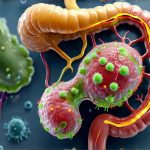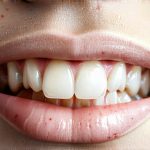The human body is often viewed as a singular entity, but in reality, it’s an incredibly complex ecosystem teeming with trillions of microorganisms – bacteria, archaea, fungi, viruses – collectively known as the microbiome. For decades, research predominantly focused on the gut microbiome, recognizing its profound influence on digestion, immunity and overall health. However, emerging evidence reveals that the oral microbiome, often overlooked, isn’t a separate entity but is deeply interconnected with gut health, significantly impacting systemic inflammation and disease risk. This intricate relationship highlights a fascinating bidirectional communication pathway between mouth and gut, challenging conventional understanding of human physiology.
The oral cavity provides an ideal environment for microbial colonization due to its warm, moist conditions and readily available nutrients. Unlike the relatively transient nature of microbes in many body sites, the oral microbiome establishes a stable, yet dynamic community that serves as a primary reservoir for species capable of migrating to other parts of the digestive tract. These migrations aren’t random; they are influenced by factors like diet, oral hygiene practices, antibiotics use and even stress levels. This constant exchange impacts the composition and function of both the oral and gut microbiomes, creating a complex interplay with far-reaching implications for health and disease. Understanding this connection is crucial for developing more holistic approaches to preventative healthcare and personalized medicine.
The Oral-Gut Axis: A Two-Way Street
The concept of an “axis” between two body sites implies not just proximity but active communication – a constant exchange of signals and microbial populations that influences the health of both locations. In this case, the oral-gut axis operates through several mechanisms. Firstly, as mentioned earlier, microbial translocation occurs; bacteria from the mouth can travel to the gut via swallowing saliva or during periods of dysbiosis (imbalance) in either location. Secondly, immune cells activated in the mouth by oral bacteria can migrate to the gut, influencing the local immune environment. Finally, shared metabolites produced by microbes in both locations – like short-chain fatty acids (SCFAs) – circulate throughout the body and impact systemic inflammation and metabolic processes.
This bidirectional relationship isn’t a one-way street. Alterations in the gut microbiome can significantly influence the oral microbiome and vice versa. For example, dysbiosis in the gut caused by dietary changes or antibiotics use can lead to increased permeability of the intestinal barrier – often referred to as “leaky gut.” This allows bacterial products and inflammatory molecules to enter the bloodstream, potentially impacting immune responses in the mouth and promoting gingivitis or periodontitis. Similarly, oral inflammation stemming from poor oral hygiene can contribute to systemic inflammation that exacerbates gut dysbiosis, creating a vicious cycle.
The implications of this axis extend beyond just localized disease. Research is beginning to link imbalances along the oral-gut axis to conditions like inflammatory bowel disease (IBD), rheumatoid arthritis, cardiovascular disease and even neurodegenerative disorders. This highlights the importance of viewing health not as isolated organ systems but as an interconnected network where disturbances in one area can ripple throughout the entire body.
Oral Microbiome Composition & Dysbiosis
A healthy oral microbiome is characterized by a diverse community of bacteria, archaea, fungi, and viruses. While over 700 bacterial species have been identified in the oral cavity, certain groups generally dominate. These include Streptococcus, Actinomyces, Veillonella, and Rothia. The specific composition varies depending on factors like age, diet, genetics, and oral hygiene habits. This diversity is key to resilience – a diverse microbiome can better resist colonization by pathogenic organisms and maintain homeostasis.
However, disruptions to this delicate balance, known as dysbiosis, can occur due to various factors:
– Poor oral hygiene leading to plaque accumulation
– Diets high in sugar and refined carbohydrates
– Antibiotics use which indiscriminately kills both beneficial and harmful bacteria
– Immunosuppression
– Stress
Dysbiosis is often characterized by an overgrowth of specific pathogenic species like Porphyromonas gingivalis, Aggregatibacter actinomycetemcomitans and Fusobacterium nucleatum. These organisms contribute to inflammation, tissue destruction and the development of periodontal disease. Importantly, dysbiotic oral microbiome compositions have been linked to increased risk of systemic inflammatory conditions as these bacteria – or their byproducts – can translocate to other body sites.
Inflammation: The Common Thread
Chronic low-grade inflammation is a hallmark of many modern diseases. The oral microbiome plays a significant role in modulating this inflammatory state, both locally and systemically. When dysbiosis occurs, the increased presence of pathogenic bacteria triggers an exaggerated immune response in the mouth, leading to gingivitis (inflammation of the gums) and periodontitis (gum disease). This local inflammation releases pro-inflammatory cytokines – signaling molecules that amplify the immune response – into the bloodstream.
These circulating inflammatory mediators can then contribute to systemic inflammation, impacting distant organs and tissues. For example, chronic periodontal inflammation has been linked to increased levels of C-reactive protein (CRP), a marker of systemic inflammation used in cardiovascular risk assessment. Furthermore, the presence of oral bacteria or their components – like lipopolysaccharide (LPS) – in the bloodstream can activate immune cells, perpetuating the inflammatory cycle.
Periodontal disease is not merely a dental problem; it’s a significant source of chronic inflammation that contributes to overall health decline. Addressing oral health through proper hygiene practices and regular dental checkups is therefore an essential component of preventative healthcare aimed at mitigating systemic inflammation. Gut microbiome balance plays a key role here too.
Dietary Influence on the Oral & Gut Microbiome
Diet plays a pivotal role in shaping both the oral and gut microbiome, influencing their composition, function and ultimately, impact on inflammation. Diets high in sugar and refined carbohydrates promote the growth of acid-producing bacteria in the mouth, leading to enamel erosion, cavities and dysbiosis. This acidic environment also favors pathogenic species associated with periodontal disease. Conversely, diets rich in fiber, fruits, and vegetables support a more diverse and balanced oral microbiome.
The gut microbiome is similarly impacted by dietary choices. Fiber acts as a prebiotic – food for beneficial gut bacteria – promoting their growth and production of SCFAs like butyrate, propionate and acetate. These SCFAs have anti-inflammatory properties and contribute to gut barrier integrity. A diet lacking in fiber can lead to reduced microbial diversity and increased intestinal permeability, exacerbating inflammation.
Interestingly, there’s a synergistic relationship between oral and gut health that is influenced by diet. For example, consuming fermented foods like yogurt or kimchi introduces beneficial bacteria to both the mouth and gut, promoting microbial balance. Reducing sugar intake not only benefits oral health but also reduces the fuel for harmful gut bacteria, further decreasing inflammation. Irregular eating can disrupt this balance too. Adopting a holistic dietary approach – one that supports both oral and gut microbiome health – is therefore crucial for optimizing overall well-being. Constipation can also play a role here.


















